人教版高中英语必修四 unit4 body language Reading 课件(共40张PPT)
文档属性
| 名称 | 人教版高中英语必修四 unit4 body language Reading 课件(共40张PPT) | 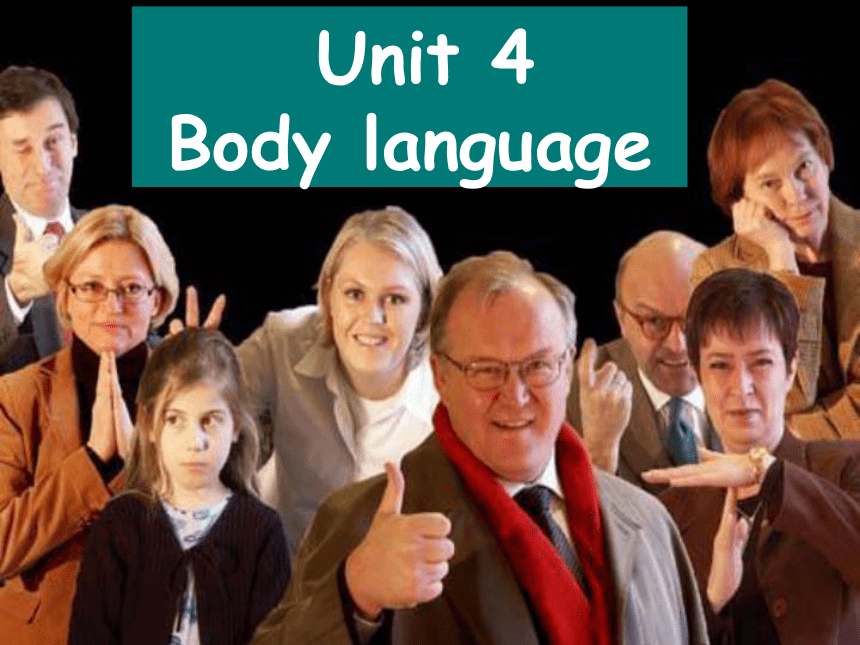 | |
| 格式 | ppt | ||
| 文件大小 | 7.2MB | ||
| 资源类型 | 教案 | ||
| 版本资源 | 人教版(新课程标准) | ||
| 科目 | 英语 | ||
| 更新时间 | 2020-09-24 08:20:04 | ||
图片预览

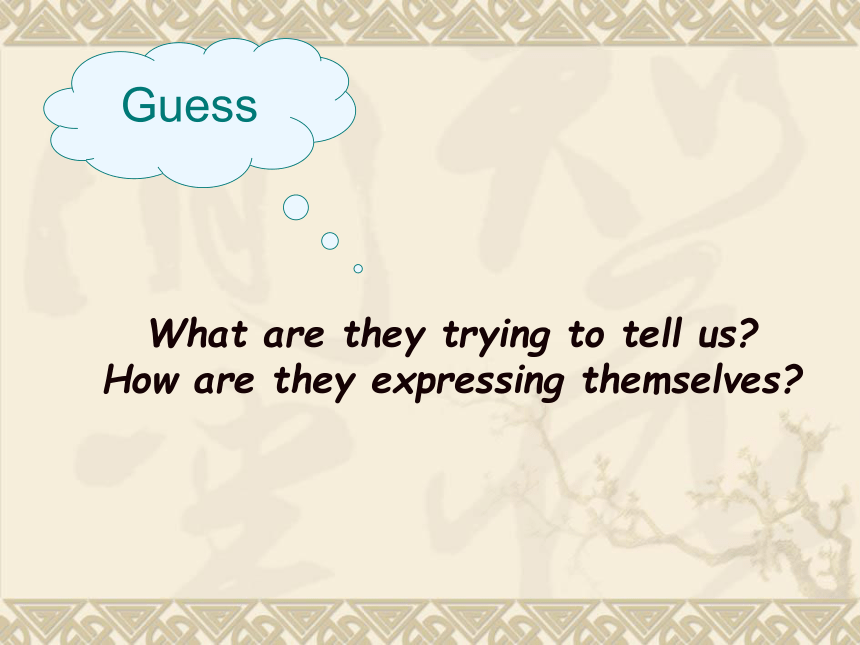
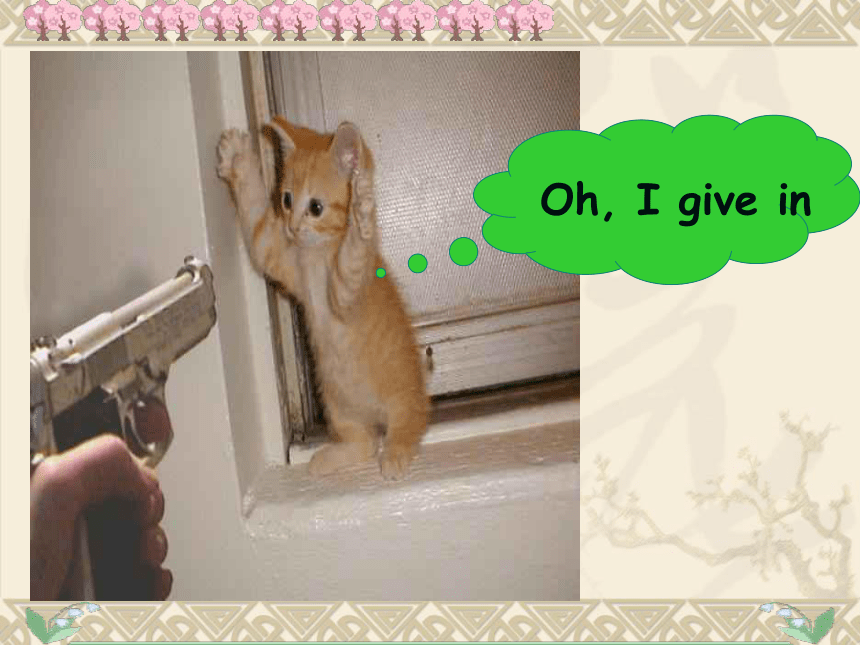
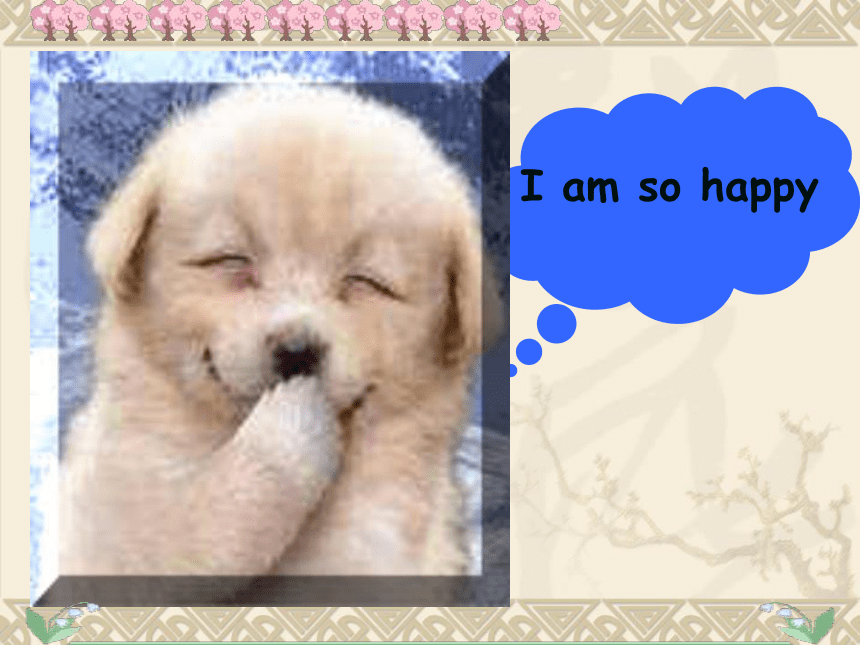
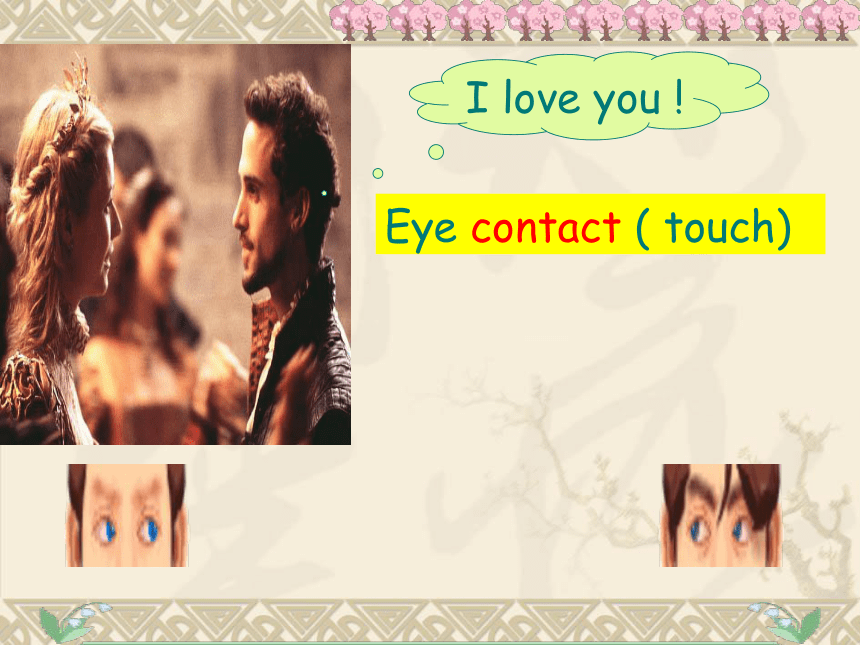
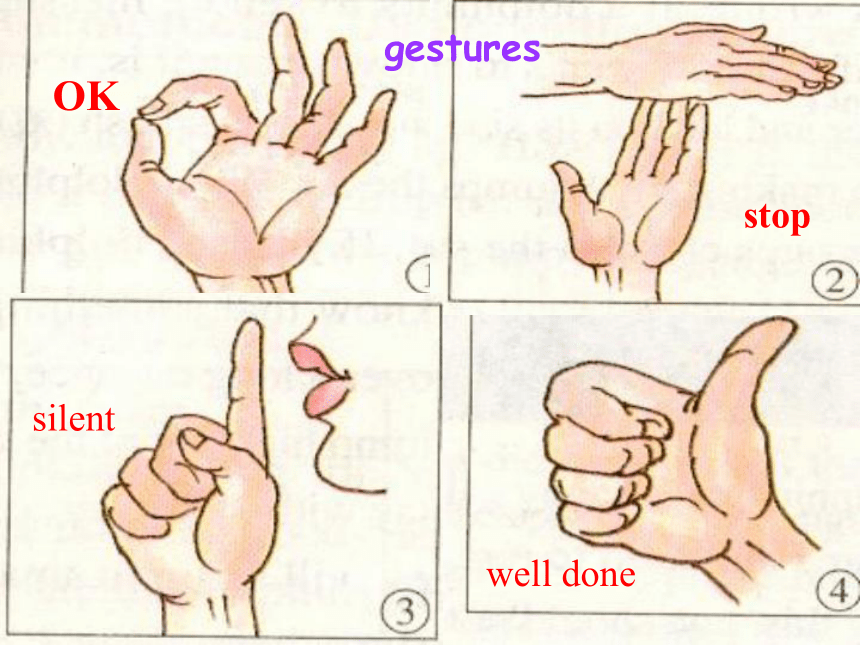
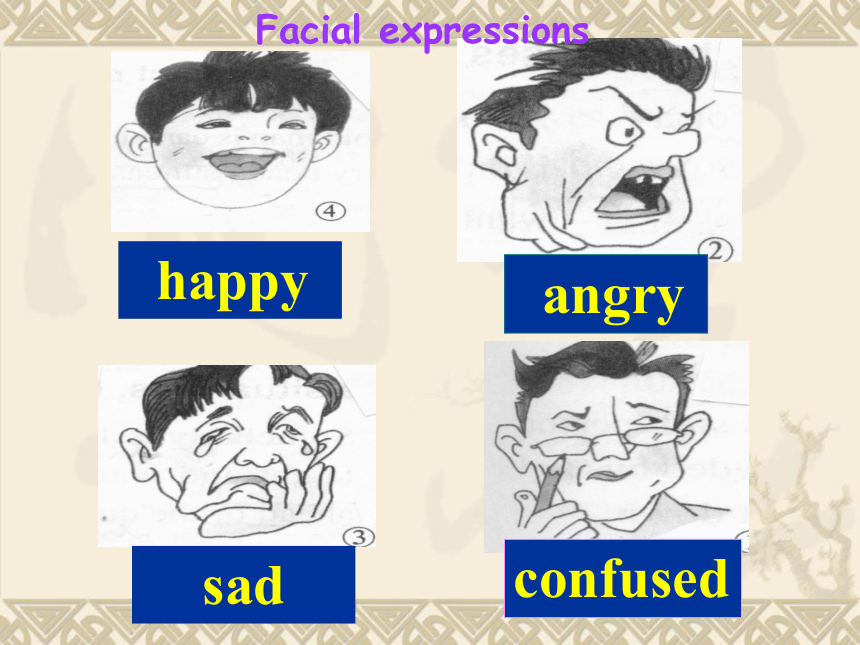
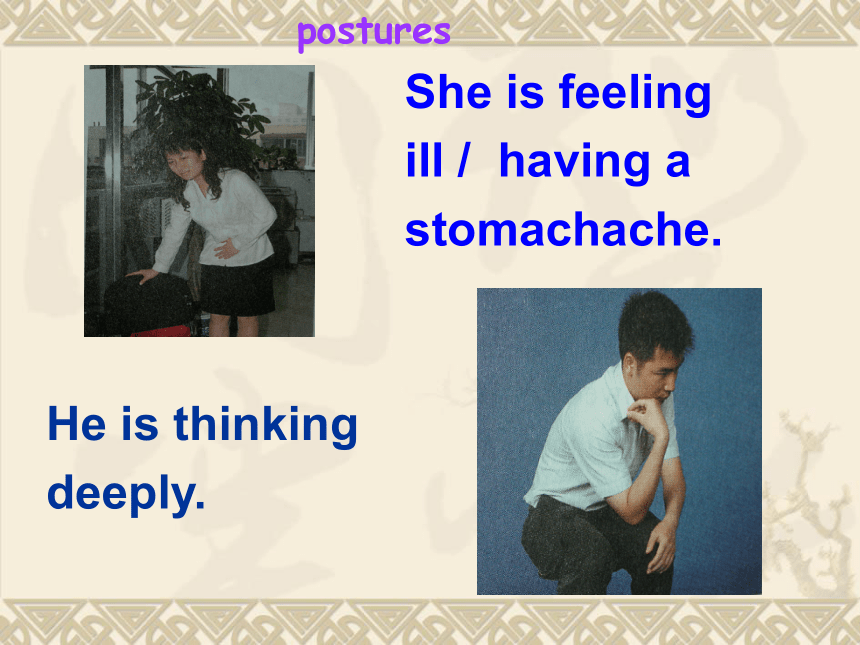
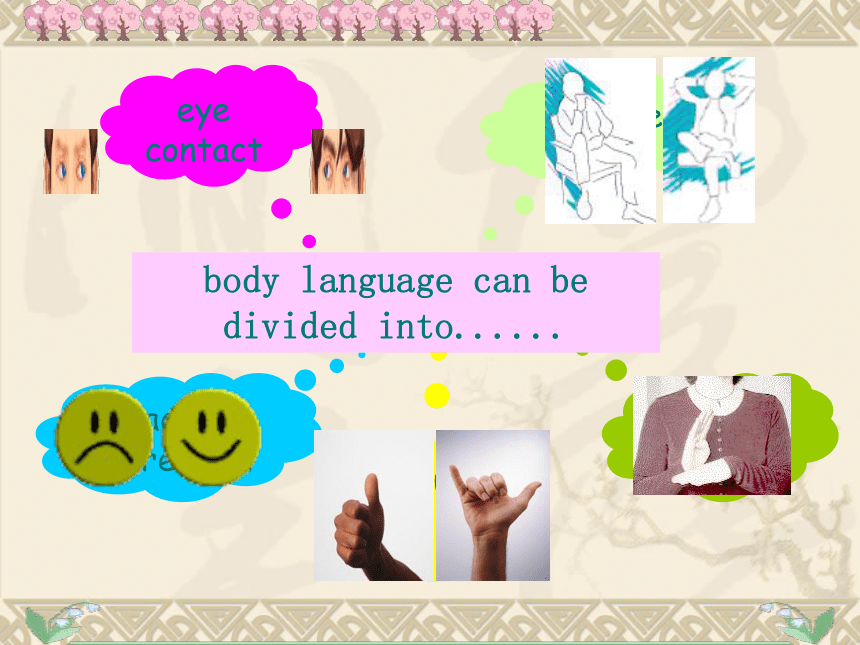
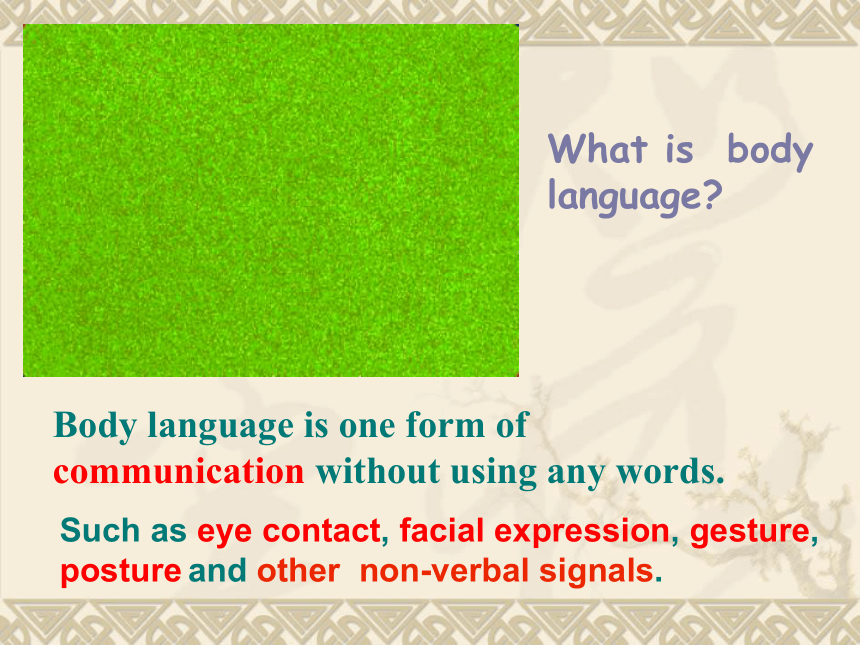
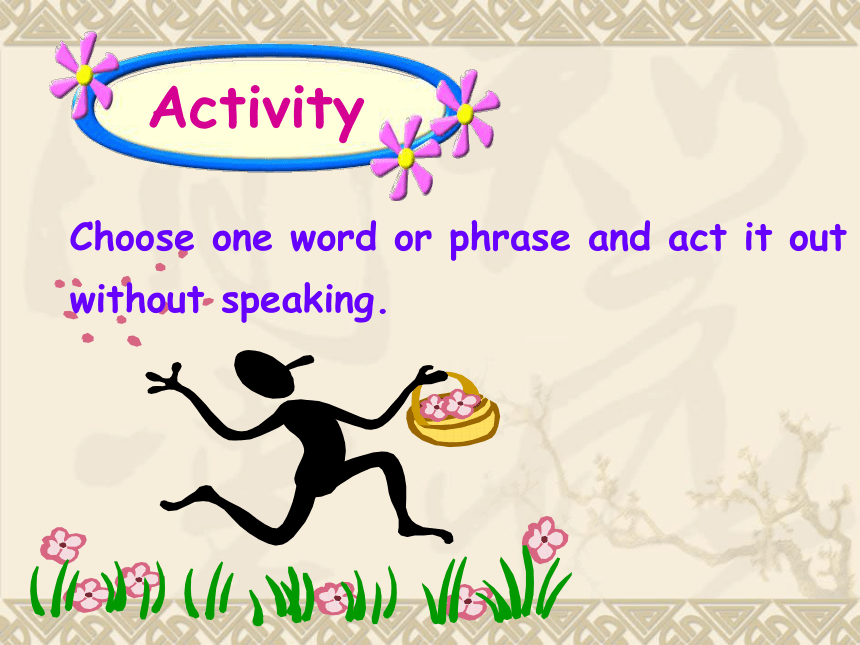
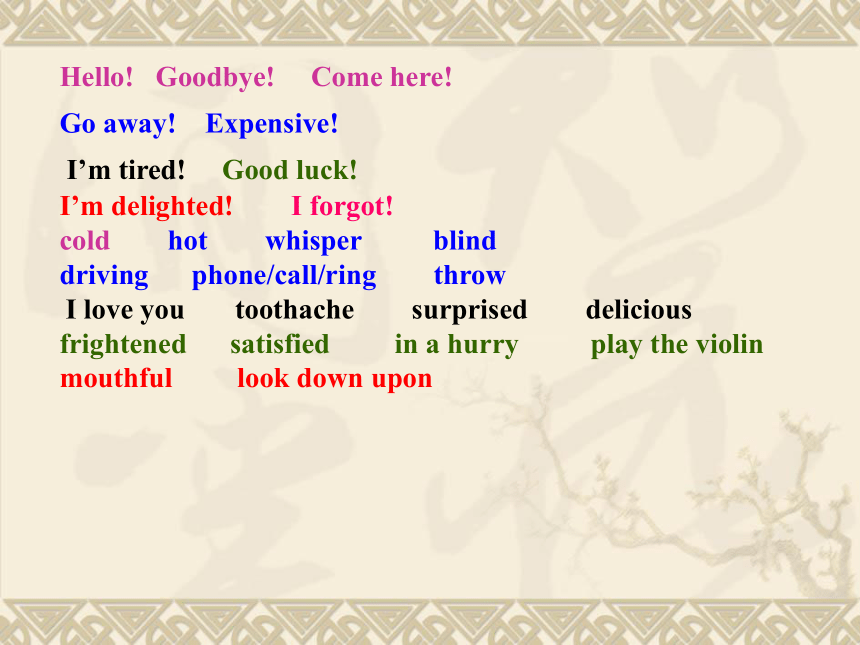
文档简介
What are they trying to tell us?
How are they expressing themselves?
Body language is one form of communication without using any words.Such as eye contact, facial expression, gesture, posture and other non-verbal signals.
1.You’re great!
2.Come and join us!
3. blow a kiss
4. wave
5. shake one’s head
1.Please stop!
2.I’m sorry!
3.This way, please!
4.nod
5.I ate too much.
1.Frown
2.Make a face
3.take photos
4.Shrug one’s shoulders
5.Wink
1.I give in.
2.OK!
3.victory
4.yawn
5.Nice to meet you.
Shake hands
Kiss
Bow
hug
Use the passage to help you answer the
following questions.
单击此处编辑母版标题样式
单击此处编辑母版副标题样式
*
*
*
Unit 4
Body language
What are they trying to tell us?
How are they expressing themselves?
Guess
Oh, I give in
I am so happy
Eye contact ( touch)
I love you !
OK
stop
silent
well done
gestures
confused
angry
sad
happy
Facial expressions
He is thinking
deeply.
She is feeling
ill / having a
stomachache.
postures
gesture
facial expression
sign language
posture
eye contact
body language can be divided into......
What is body language?
Such as eye contact, facial expression, gesture, posture and other non-verbal signals.
Body language is one form of communication without using any words.
Activity
Choose one word or phrase and act it out without speaking.
Hello! Goodbye! Come here!
Go away! Expensive!
I’m tired! Good luck!
I’m delighted! I forgot!
cold hot whisper blind
driving phone/call/ring throw
I love you toothache surprised delicious
frightened satisfied in a hurry play the violin mouthful look down upon
Action show
Some body language is similar in most countries.
As one coin has two sides
Some body language is
in
different countries.
different
In China, Britain
In Russia, France,
In Arab, Japan, Korea
In Some western countries
What do people usually do when meeting?
Reading
Communication:
No problem?
Look at the title and the picture and predict what the topic will be in this passage?
Listening and underlining
1.Who are the people mentioned in the passage?
2.Where are they from?
people
country
China
Tony Garcia
Columbia
Julia Smith
Britain
Akira Nagata
Japan
George Cook
Canada
Ahmed Aziz
Jordan
Darlene Coulon
France
another student and I
Tony Garcia
Ahmed
Aziz
Julia Smith
Akira
Nagata
George
Cook
Darlene
Coulon
Divide the passage into four parts
and match the main idea of each part.
Fast reading
C) to meet international students at Capital International Airport.
A) Summary of body language.
B) Different cultures, different body languages.
D) Examples of cultural “body language”.
(Para1)
(Para 2 and 3)
(Para 4)
(Para5)
Part 1 :
Part 2:
Part 3:
Part 4:
careful reading
Part1
1 . Who did another student and I meet at the airport?
2 . Why were they visiting China?
meet
International students
They were coming to study at Beijing University.
Para2: Find out the two cultural mistakes the author found at the airport:
Tony Garcia
Julia Smith
The first cultural mistake
from
from
(Columbia )
(Britain)
He approached Julia , _______ ______ _________ and _______ her on the ________.
She ______ ________ appearing _________ and put up her hands, as if in _________.
shoulder
touched
her
kissed
cheek
stepped back
surprised
defence
The second
cultural
mistake
Akira Nagata
from
George Cook
from
(Canada)
He ________ ________ _______ ________ to the Japanese.
He ________ to Mr. Cook and his nose _________ George’s _______ ________.
bowed
touched
moving
hand
reached
his hand
out
(Japan)
Tony Garcia (Columbia)
Julia Smith (Britain)
Akira Nagata (Japan)
George Cook (Canada)
Darlene Coulon (France)
Matching the people and their different ways of greeting (para2&3)
shakes hands and kisses others twice on each cheek
bows
shakes hands
approaches others closely and touches their shoulder and kisses them on the cheek
does not stand very close to others or touch strangers
Part 2
Read paragraph3-5, then decide if the following statements are true (T) or false (F) and correct the error.
Englishmen often stand close to others or touch strangers as soon as they meet.
Most people around the world now greet each other by kissing .
Japanese will bow to others as greeting.
People from Jordan will move very close to you as you introduce yourself to them.
Some body languages in some countries are good while some countries’ body language are bad.
Task : discussion
1 Is the author of this passage male or female? How do you know?
2“ When in Rome, do as the Romans do.” What do you think this famous saying means?
1 Is the author of this passage male or female? How do you know?
male.
Ahmed Aziz did not shake hands
with women, but he shook with
the author.
2“ When in Rome, do as the Romans do.” What do you think this famous saying means?
when we are in a certain place, we should follow the customs there, not our own .
Fill in the blanks:
The first person to arrive was Tony Garcia from Columbia, closely _________ by Julia Smith from Britain. When they were introduced to each other, Tony approached Julia, _______ her shoulder and _______ her on the cheek . Julia stepped back appearing surprised. Akira Nagata
from Japan came in smiling at the same time with George Cook from Canada. As they were introduced, George _______ his hand out to the Japanese who ______ . His nose touched George’s moving hand, and they both _________.
followed
touched
kissed
reached
bowed
apologized
These are examples of learned or cultural “body language”. Not all cultures ________ each other the same way, nor are they comfortable touching strangers or being too close or too far away. In the same way that people ____________ with spoken language, they also __________ their feelings using unspoken “language” through keeping physical distance, actions or _________.
express
communicate
greet
posture
Fill in the blanks:
Summary :
Body language differs from culture to culture. Not all members of all cultures behave the same way. We should try to grasp and respect each other’s culture in order to make good communication.
Fun learning
If you are happy
Listen to and sing the song
do the three kinds of body language
If you’re happy and you know it __________________
If you're happy and you know it __________________
If you're happy and you know it never be afraid to show it
If you're happy and you know it __________________
If you're happy and you know it __________________
If you're happy and you know it __________________
If you're happy and you know it Never be afraid to show it
If you're happy and you know it __________________
If you're happy and you know it __________________
If you're happy and you know it __________________
If you're happy and you know it never be afraid to show it
If you're happy and you know it __________________
clap your hands
clap your hands
clap your hands
stomp your feet
stomp your feet
stomp your feet
wink your eye
wink your eye
wink your eye
Homework
1. Make a list of facial expressions and gestures and their meanings we’ve learned today.
2. Go over the reading passage on P26.
Body language is one form of communication without using any words.Such as eye contact, facial expression, gesture, posture and other non-verbal signals.
1.You’re great!
2.Come and join us!
3. blow a kiss
4. wave
5. shake one’s head
1.Please stop!
2.I’m sorry!
3.This way, please!
4.nod
5.I ate too much.
1.Frown
2.Make a face
3.take photos
4.Shrug one’s shoulders
5.Wink
1.I give in.
2.OK!
3.victory
4.yawn
5.Nice to meet you.
Shake hands
Kiss
Bow
hug
Use the passage to help you answer the
following questions.
单击此处编辑母版标题样式
单击此处编辑母版副标题样式
*
*
*
Unit 4
Body language
What are they trying to tell us?
How are they expressing themselves?
Guess
Oh, I give in
I am so happy
Eye contact ( touch)
I love you !
OK
stop
silent
well done
gestures
confused
angry
sad
happy
Facial expressions
He is thinking
deeply.
She is feeling
ill / having a
stomachache.
postures
gesture
facial expression
sign language
posture
eye contact
body language can be divided into......
What is body language?
Such as eye contact, facial expression, gesture, posture and other non-verbal signals.
Body language is one form of communication without using any words.
Activity
Choose one word or phrase and act it out without speaking.
Hello! Goodbye! Come here!
Go away! Expensive!
I’m tired! Good luck!
I’m delighted! I forgot!
cold hot whisper blind
driving phone/call/ring throw
I love you toothache surprised delicious
frightened satisfied in a hurry play the violin mouthful look down upon
Action show
Some body language is similar in most countries.
As one coin has two sides
Some body language is
in
different countries.
different
In China, Britain
In Russia, France,
In Arab, Japan, Korea
In Some western countries
What do people usually do when meeting?
Reading
Communication:
No problem?
Look at the title and the picture and predict what the topic will be in this passage?
Listening and underlining
1.Who are the people mentioned in the passage?
2.Where are they from?
people
country
China
Tony Garcia
Columbia
Julia Smith
Britain
Akira Nagata
Japan
George Cook
Canada
Ahmed Aziz
Jordan
Darlene Coulon
France
another student and I
Tony Garcia
Ahmed
Aziz
Julia Smith
Akira
Nagata
George
Cook
Darlene
Coulon
Divide the passage into four parts
and match the main idea of each part.
Fast reading
C) to meet international students at Capital International Airport.
A) Summary of body language.
B) Different cultures, different body languages.
D) Examples of cultural “body language”.
(Para1)
(Para 2 and 3)
(Para 4)
(Para5)
Part 1 :
Part 2:
Part 3:
Part 4:
careful reading
Part1
1 . Who did another student and I meet at the airport?
2 . Why were they visiting China?
meet
International students
They were coming to study at Beijing University.
Para2: Find out the two cultural mistakes the author found at the airport:
Tony Garcia
Julia Smith
The first cultural mistake
from
from
(Columbia )
(Britain)
He approached Julia , _______ ______ _________ and _______ her on the ________.
She ______ ________ appearing _________ and put up her hands, as if in _________.
shoulder
touched
her
kissed
cheek
stepped back
surprised
defence
The second
cultural
mistake
Akira Nagata
from
George Cook
from
(Canada)
He ________ ________ _______ ________ to the Japanese.
He ________ to Mr. Cook and his nose _________ George’s _______ ________.
bowed
touched
moving
hand
reached
his hand
out
(Japan)
Tony Garcia (Columbia)
Julia Smith (Britain)
Akira Nagata (Japan)
George Cook (Canada)
Darlene Coulon (France)
Matching the people and their different ways of greeting (para2&3)
shakes hands and kisses others twice on each cheek
bows
shakes hands
approaches others closely and touches their shoulder and kisses them on the cheek
does not stand very close to others or touch strangers
Part 2
Read paragraph3-5, then decide if the following statements are true (T) or false (F) and correct the error.
Englishmen often stand close to others or touch strangers as soon as they meet.
Most people around the world now greet each other by kissing .
Japanese will bow to others as greeting.
People from Jordan will move very close to you as you introduce yourself to them.
Some body languages in some countries are good while some countries’ body language are bad.
Task : discussion
1 Is the author of this passage male or female? How do you know?
2“ When in Rome, do as the Romans do.” What do you think this famous saying means?
1 Is the author of this passage male or female? How do you know?
male.
Ahmed Aziz did not shake hands
with women, but he shook with
the author.
2“ When in Rome, do as the Romans do.” What do you think this famous saying means?
when we are in a certain place, we should follow the customs there, not our own .
Fill in the blanks:
The first person to arrive was Tony Garcia from Columbia, closely _________ by Julia Smith from Britain. When they were introduced to each other, Tony approached Julia, _______ her shoulder and _______ her on the cheek . Julia stepped back appearing surprised. Akira Nagata
from Japan came in smiling at the same time with George Cook from Canada. As they were introduced, George _______ his hand out to the Japanese who ______ . His nose touched George’s moving hand, and they both _________.
followed
touched
kissed
reached
bowed
apologized
These are examples of learned or cultural “body language”. Not all cultures ________ each other the same way, nor are they comfortable touching strangers or being too close or too far away. In the same way that people ____________ with spoken language, they also __________ their feelings using unspoken “language” through keeping physical distance, actions or _________.
express
communicate
greet
posture
Fill in the blanks:
Summary :
Body language differs from culture to culture. Not all members of all cultures behave the same way. We should try to grasp and respect each other’s culture in order to make good communication.
Fun learning
If you are happy
Listen to and sing the song
do the three kinds of body language
If you’re happy and you know it __________________
If you're happy and you know it __________________
If you're happy and you know it never be afraid to show it
If you're happy and you know it __________________
If you're happy and you know it __________________
If you're happy and you know it __________________
If you're happy and you know it Never be afraid to show it
If you're happy and you know it __________________
If you're happy and you know it __________________
If you're happy and you know it __________________
If you're happy and you know it never be afraid to show it
If you're happy and you know it __________________
clap your hands
clap your hands
clap your hands
stomp your feet
stomp your feet
stomp your feet
wink your eye
wink your eye
wink your eye
Homework
1. Make a list of facial expressions and gestures and their meanings we’ve learned today.
2. Go over the reading passage on P26.
同课章节目录
